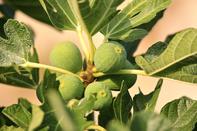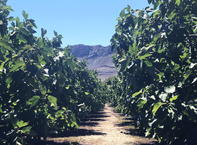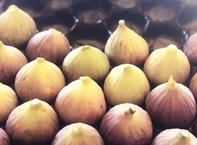Figs are well adapted to dry areas with high temperatures, and low water availability and have traditionally been cultivated in marginal soils.

Nowadays, fig farming is increasingly practised under irrigation with different agricultural techniques to increase yield, quality and shelflife.
Fig trees are also successfully grown in open orchards, under shade netting, in greenhouses and in hydroponic systems. In fact, a study in Japan has found that fig trees in a hydroponic system can produce two crops in a year, with a special pruning procedure.
Mexican studies have shown that intensive production of fig trees in greenhouse and hydroponic systems produced up to 20 times more fruit than in open-land cultivation.
Fig Trees

Figs prefer a Mediterranean climate - warm, dry summers and temperate winters. Warm dry weather during harvesting in summer, is essential, as moisture can cause cracks in ripening figs.
Fig trees are planted in orchards with trees ideally aligned in a south-north direction to allow for the even ripening of fruit on both sides of the tree. Figs can be planted in sandy soil, but richer soils may yield bigger fruit. It can tolerate a wide range of soil types but prefers a pH of 6 - 6,5.
Fig trees have shallow, spreading root systems, which are sensitive to weed competition. In terms of pests, figs are relatively sensitive to nematodes and stem-borer. Trees may require nitrogen, depending on soil analyses. Drip irrigation is used; regular light irrigation is preferred to weekly deep watering.
Fig trees are pruned during the South African winter months, June to September, to keep the trees ‘open’ for sunlight penetration and low for easier handpicking. Pruning for cultivars, e.g. ‘White Genoa’, bearing early figs or ‘breba’ figs should be adapted. Breba figs develop about a month before the main harvest, on shoots of the previous year, whereas the second or main crop of figs develops on shoots that grow during the current season.
Harvesting of Figs

Fig ripens quickly and trees’ are harvested daily, usually over a period of a couple of months. Depending on the variety and area, harvesting of figs starts from November/December and can last until April/May. Figs are picked very early in the morning to avoid the midday heat, as this can cause damage of the figs - the fig stalks detach from the fruit and stay on the tree.
Optimal harvesting is a few days before optimal ripening, about 70% ripeness. Picking early limits bird damage of ripe figs in the orchard. The fig is a climacteric fruit and will ripen while being transported to the end-consumer.
Fig harvesting is labour-intensive; figs bruise easily and must be handled with care. The fig tree exudes a white latex or ‘milk’ which causes skin blisters, so pickers wear gloves, sleeves and sometimes scarves to prevent their skin being exposed to the acidic ‘milk’.
After harvesting, figs are moved to cold storage, sorted for size and quality and then packed. Export quality figs can be packed in plastic punnets of 160 grams, or tubs for the small Ronde de Bordeaux figs. Larger figs are also exported in paper trays inside flat boxes.
If figs are not suitable for the fresh eating market, e.g. cracked or too ripe, they are sent for processing into jams, chutneys or for drying.
By Marinda Louw